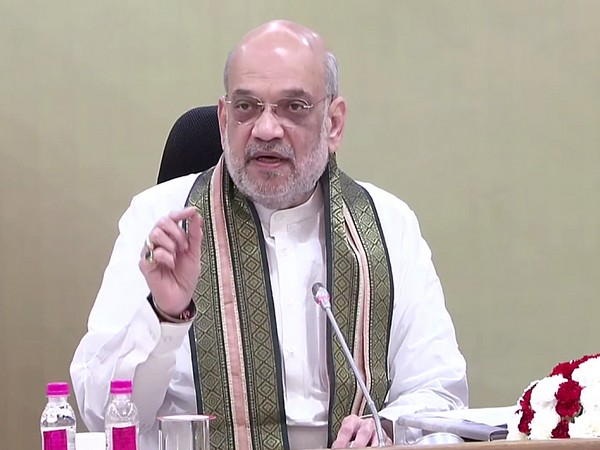New Delhi [India], August 21 (ANI): Union Home Minister Amit Shah is scheduled for a two-day visit to Chhattisgarh from August 24, where he will assess anti-Naxal operations alongside the police chiefs and chief secretaries from neighbouring states affected by Naxal insurgency.
The annual engagement is aimed at evaluating and enhancing strategies to tackle the challenges related to Naxal activities.
In the meeting, which is expected to be held in Chhattisgarh’s capital, Raipur, the Home Minister will assess both the measures taken against Naxal insurgency and the advancement of infrastructure projects in regions known as Red corridors within nine states troubled by Left Wing Extremism (LWE).
Shah will arrive in Raipur on August 23 night and commence a series of meetings beginning on August 24. These meetings will feature an interstate coordination engagement with chief secretaries and director generals of police from neighbouring states, as well as a security and development meeting on LWE-affected areas of Chhattisgarh.
The meeting is learnt to be attended by the police chiefs of Chhattisgarh, Andhra Pradesh, Jharkhand, Kerala, Madhya Pradesh, Maharashtra, Odisha, Telangana and West Bengal–the states where Naxalism has been constricted, as per the latest data collated by the Ministry of Home Affairs. Besides, Union Home Secretary Govind Mohan and Director Intelligence Bureau Tapan Deka Central Reserve Police Force (CRPF) Chief Anish Dayal Singh are also expected to attend these two meetings.
On August 25, the Home Minister will inaugurate Raipur Narcotics Control Bureau (NCB) office following a review meeting in the morning. The Home Minister will also chair a meeting on the expansion of Cooperation in Chhattisgarh on August 24.
The anti-Naxal meeting is significant at a time when, as per the Home Ministry’s latest data, the geographical spread of LWE violence has substantially fallen with a reduction of LWE-affected districts from 126 across 10 states in 2013 to only 38 districts in 2024 (with effect from April-2024) across nine states: Chhattisgarh, Andhra Pradesh, Jharkhand, Kerala, Madhya Pradesh, Maharashtra, Odisha, Telangana and West Bengal.
MHA’s data reveals that maximum of 15 districts from Chhattisgarh–Bijapur, Bastar, Dantewada, Dhamtari, Gariyaband, Kanker, Kondagaon, Mahasamund, Narayanpur, Rajnandgaon, Mohalla-Manpur- Ambagarh chowki, Khairgarh- ChhuikhadanGandai, Sukma, Kabirdham and Mungeli–are now affected with Naxaism menace, followed by seven districts of Odisha namely Kalahandi, Kandhamal, Bolangir, Malkangiri, Nabrangpur, Nuapada and Rayagada.
As per the data, naxalism is only restricted to five districts (Giridih, Gumla, Latehar, Lohardaga and West Singhbhum) of Jharkhand as well as three districts (Balaghat, Mandla and Dindori) of Madhya Pradesh. The LWE regions are limited to just two districts in Kerala (Wayanad and Kannur), two districts in Maharashtra (Gadchiroli and Gondia), and two districts in Telangana (Bhadradri-Kothagudem and Mulugu). Additionally, the naxal-affected areas in Andhra Pradesh and West Bengal are restricted to just one district each in Alluri Sitaramraju and Jhargram, respectively.
The MHA data was shared by Union Minister of State for Home Nityanand Rai in Parliament in the recently concluded Budget Session, informing that the credit for the significant achievement goes to the central government’s national policy and action plan approved in 2015 to address the LWE menace.
The LWE violence incidents have reduced by 73 per cent from the high level of LWE violence incidents in 2010, the MoS had said, adding “the resultant deaths (security forces and civilians) have reduced by 86 per cent from the all-time high of 1,005 in 2010 to 138 in 2023.
“In the current year 2024 (up to June 30, 2024), there has been a sharp reduction of 32 per cent in LWE perpetrated incidents and 17 per cent in the resultant deaths of civilians and security force personnel in comparison to the figures for the corresponding period of 2023.”
He further said that the number of police stations reporting LWE-related violence has significantly reduced from 465 police stations in 96 districts in 2010 to 171 police stations across 42 districts in 2023.
In 2024 (up to June 2024), LWE violence was reported from 89 police stations across 30 districts, the MoS had added.
During the last 10 years since 2014-15, Rs 6,908 crore have been released for capacity building in the LWE-affected states under the Special Infrastructure Scheme (SIS), Security Related Expenditure (SRE) and Special Central Assistance (SCA) schemes. Further, Rs 1000 crore has been given to Central Agencies for helicopters and addressing critical infrastructure in security camps in LWE-affected areas, under the Assistance to Central Agencies for LWE Management (ACALWEM) Scheme.
On the development front, apart from flagship schemes, the central government has taken several specific initiatives in LWE-affected states, with a special thrust on the expansion of road network, improving telecom connectivity, skill development and financial inclusion. (ANI)
Disclaimer: This story is auto-generated from a syndicated feed of ANI; only the image & headline may have been reworked by News Services Division of World News Network Inc Ltd and Palghar News and Pune News and World News
HINDI, MARATHI, GUJARATI, TAMIL, TELUGU, BENGALI, KANNADA, ORIYA, PUNJABI, URDU, MALAYALAM
For more details and packages
















